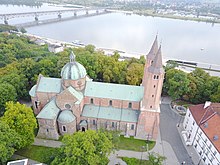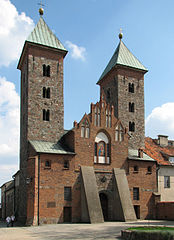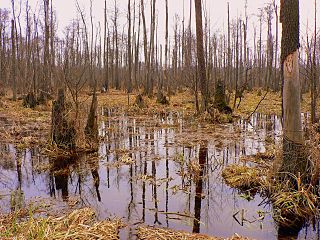| |||
| Mazovia | |||
| Capital | Warsaw | ||
|---|---|---|---|
| Residents | 5.492.000 (2011) | ||
| surface | 35,566 km² | ||
| no tourist info on Wikidata: | |||
| location | |||
 | |||

Masovian Voivodeship (Polish województwo mazowieckie [vɔjɛˈvutstfɔ mazɔˈvjɛtskʲɛ]) is in the central Poland is the largest Polish voivodeship with the capital in Warsaw. More big cities are Plock and Radome. The voivodeship borders the voivodeships to the west Kuyavian Pomeranian and Łódź, in the south to the Świętokrzyskie Voivodeship, in the east to the voivodships Podlaskie and Lublin, and in the north to the Warmian-Masurian Voivodeship. The name can be translated as Land of the swamp people or Land of swamps interpret. According to another opinion, the name derives from level or the name Miecław, the king's cupbearer Mieszko Lambertwho ruled the country in the early 11th century. The name is derived from Mazovia Masuria that was settled by the Mazovians. The voivodeship is in the south by rolling hills and the Lesser Poland Vistula Gorge, in the center, north and east by the valleys of the Vistula, of Bug and the Narew as well as the marshland surrounding them and shaped almost everywhere by dense forests.
Brick-Gothic castle ruins and churches testify to the pride of the independent Piast princes in the Middle Ages, and baroque and classicist palaces testify to the wealth of the Polish nobility in the early modern period. There are numerous traces of Jewish culture. As a plain, Mazovia is characterized by numerous avenues of willow trees and streams. The romantic, melancholy landscape shaped the mazurkas and polonaises Fryderyk Chopinswho is in Żelazowa Wola was born in Mazovia and grew up in Warsaw. In contrast to the dark green forests are the white fine-grain sand, through whose sandbanks sky-blue rivers meander wildly. Warsaw As the largest Polish metropolis, it is characterized by numerous baroque and classicist palaces and parks and many baroque and romantic parks, which make it one of the greenest cities in Europe.
Regions
Historical Mazovia occupies the northern and central parts of the voivodeship, while larger parts of it are also in the voivodeships Łódź and Podlaskie lie. Small parts of historical Mazovia are also in the voivodeships Warmia-Masuria and Lublin. In contrast, the voivodeship in the east has a large share of the historical region Podlaskie and in the south Lesser Poland. Also a small part of the eastern one Kuyavia is in the voivodeship.
The historical Mazovia can in turn be divided into three regions, the Plotzker country, the Rawaer country and the Czersker country. The eastern part of the Plotzker Land is also called Zawkrze, the northern part of the Rawaer Land as Kurpie and the northern part of the Czersker Lands as Warsaw country designated.
Mazovia is by the middle Vistula and their tributaries are marked. In the south there is a hill country around RadomeOtherwise the glacial valley of the Vistula, the Warsaw Basin and the Mazovian Plain form the image of the region.
- The historical one Lesser Poland south of the Pilitza is characterized by rolling hills.
- The historical one Podlaskie on the eastern Bug is a sparsely populated marshland.
- The Plotzker Land with the capital Plock was temporarily the seat of government of the Kingdom of Poland in the High Middle Ages. The brick-Gothic architecture still characterizes numerous old towns.
- That too Zawkrze, so the country out Plocker View behind (east) the Wkra, is strongly influenced by the brick Gothic. The seat of power was here Ciechanów.
- The Rawaer Land ran as a long strip from the southwest through the center to the northeast of Mazovia. Prince's seat was Rawa Mazowiecka. Here, too, the brick Gothic was predominant.
- The region occupies the northern sparsely populated part of the Rawaer Land Kurpie at the Kurpie Heath and the lower reaches of the Narew and Biebrza a.
- The Czersk Land formed the southern and eastern parts of Mazovia on the Vistula, the Bug and the Liwiec. First was the seat of a prince Czersk on the upper Vistula. 1406 was the seat after Warsaw Relocated downstream.
- The Warsaw country forms the core region of the voivodeship. It is the economically strongest and most densely populated region of the voivodeship and all of Poland. The metropolitan region is very different from the otherwise very natural surroundings of the voivoship.
places
Plotzker Land
Zawkrze
Rawaer Land
- 17 Mszczonów

- 18 Żyrardów

- 19 Sochaczew

- 20 Żelazowa Wola
- 21 Brochów
- 22 Czerwińsk nad Wisłą

- 23 Zakroczym

- 24 Nowy Dwór Mazowiecki

- 25 Serock

- 26 Nasielsk

- 27 Pułtusk

- 28 Różan

- 29 Maków Mazowiecki

- 30 Przasnysz

Krupie
- 31 Chorus cele

- 32 Myszyniec

- 33 Ostrołęka

Warsaw metropolitan area
- 34 Błonie

- 35 Grodzisk Mazowiecki

- 36 Milanówek

- 37 Brwinów

- 38 Podkowa Leśna

- 39 Pruszków

- 40 Piastów

- 41 Ożarów Mazowiecki

- 42 Warsaw

- 43 Łomianki

- 44 Jabłonna

- 45 Legionowo

- 46 Radzymin

- 47 Wołomin

- 48 Kobyłka

- 49 Marki

- 50 Zielonka

- 51 Ząbki

- 52 Sulejówek

- 53 Halinów

Czersk Land
- 54 Nowe Miasto nad Pilicą

- 55 Mogielnica

- 56 Warka

- 57 Magnuszew
- 58 Grójec

- 59 Tarczyn

- 60 Piaseczno

- 61 Góra Kalwaria

- 62 Czersk
- 63 Konstancin-Jeziorna

- 64 Pilawa

- 65 Karczew

- 66 Otwock

- 67 Józefów

- 68 Mińsk Mazowiecki

- 69 Kałuszyn

- 70 Mrozy

- 71 Siedlce

- 72 Liw

- 73 Węgrów

- 74 Tłuszcz

- 75 Łochów

- 76 Wyszków

- 77 Brok

- 78 Ostrów Mazowiecka

Podlaskie
- 79 Treblinka
- 80 Kosów Lacki

- 81 Sokołów Podlaski

- 82 Mordy

- 83 Łosice
Lesser Poland
- 84 Garwolin

- 85 Żelechów

- 86 Łaskarzew

- 87 Białobrzegi

- 88 Wyśmierzyce
- 89 Kozienice

- 90 Pionki

- 91 Czarnolas
- 92 Zwoleń

- 93 Radome

- 94 Przysucha

- 95 Szydłowiec

- 96 Skaryszew
- 97 Iłża

- 98 Lipsko

- 99 Solec nad Wisłą
Other goals
The voivodeship has a share in seven large forest areas:
- The 1 Bolimów Heath lies in the west of the voivodeship.
- The 2 Heiligkreuz-Heath is in the south of the voivodeship.
- The 3 Johannisburger Heide is in the north of the voivodeship.
- The 4 Kampinos jungle is in the west of the voivodeship.
- The 5 Kurpie Heath is in the north of the voivodeship.
- The 6 White heather is in the east of the voivodeship.
- The 7 Łuków Heath is located in the southeast of the voivodeship.
National parks
There is a national park in the voivodeship:
- The 8 Kampinos National Park is west of Warsaw.
Kayak and houseboat trails
- Brok
- Bug
- Bzura
- Drzewiczka
- Długa
- Iłżanka
- Jeziorka
- Kamienna
- Left Skrwa
- Liwiec
- Narew
- Nurzec
- Orschütz
- Pilitza
- Pisia
- Radomka
- Rawka
- Right Skrwa
- Rosogga
- Sierpienica
- Sona
- Szkwa
- Vistula-Bug Canal
- Wilga
- Wkra
- Vistula
- Węgierka
- Łydynia
- Świder
Lakes
background

Mazovia came to Poland in the 10th century. In the 11th century it was Plock capital of Poland for a short time. The kings are in Płock Cathedral Herman and Boleslaus III to bury. During the period of territorial fragmentation from 1138 onwards, it was a principality and split up into several duchies ruled by the Mazovian Piasts. Here, the division into three areas turned out to be Plock, Czersk and Rawa Mazowiecka as permanent. 1226 fetched Conrad of Mazovia the German Order into Dobriner and Kulmer Landthat previously belonged to his domain. After a short reunification of Mazovia around 1300 and 1370. Mazovia became a Polish fiefdom as early as the middle of the 14th century. With the extinction of the Piasts, the Principality of Rawa came back to Poland as voivodeships in 1462/1476, followed by the Principality of Płock in 1495 and finally in 1526 the Principality of Czersk, now with its capital in Warsaw since 1406. In 1526 the Mazovian Reichstag and in 1529 the Polish Reichstag confirmed the incorporation of Mazovia into Poland. Numerous brick Gothic buildings have been preserved from the time of Piastic Mazovia.
After the completion of the Polish-Lithuanian real union with the Union of Lublin in 1569, Mazovia moved from the outskirts to the center of the aristocratic republic, the population grew, trade - especially on the Vistula, art and culture flourished. In 1596 Warsaw became the capital of the Polish-Lithuanian aristocratic republic and the royal court also moved from Krakow to Warsaw. Little by little the influential magnates also settled in and around Warsaw in order to be close to the political events, especially at the meetings of the Reichstag. Baroque and classicist palaces emerged, the petty nobility built manors in the Mazovian villages around Warsaw. Artists and architects from Italy, Saxony and France designed the residences of the powerful secular and ecclesiastical princes. Baroque monasteries and church buildings soon shaped the whole of Mazovia.
After the three partitions of Poland, Mazovia came to Prussia and Austria at the end of the 18th century, to the Grand Duchy of Warsaw under Napoleon and to Russia as Congress Poland after the Congress of Vienna. After the First World War it became Polish again and Warsaw became the capital of Poland again.
Warsaw was badly damaged in World War II. The Jewish population murdered in the ghettos and the Treblinka concentration camp. The reconstruction has already taken several decades, but is still not complete. Warsaw's old and new towns are already shining in new splendor, for which they have been included in the UNESCO World Heritage Site. In 1999, today's Masovian Voivodeship was founded.
The most famous part of Mazovian folklore is the dance and song ensemble Mazowsze.
language
Polish is the official and colloquial language. Polish is spoken with different dialects, depending on which part of the voivodeship you are in. In the south it is the Lesser Poland dialect, in the east the Podlachian and in the center the Mazovian dialect. In Warsaw, on the other hand, you will find a mishmash of all Polish dialects, as many Poles have recently moved to the capital. Foreign language skills are particularly good in the Masovian Voivodeship, especially in Warsaw. Almost all of the younger residents speak very good or good English. And finally, Polish is not as difficult to learn as you might think at first.
getting there


We recommend arriving by plane, car, bus or train.
By plane
In the region lies the 1 Warsaw Airport![]() (IATA: WAW), the largest airport in Poland, which can be approached directly from Germany, Austria and Switzerland. There is also the 2 Modlin Airport
(IATA: WAW), the largest airport in Poland, which can be approached directly from Germany, Austria and Switzerland. There is also the 2 Modlin Airport![]() (IATA: WMI)which is mainly used by low-cost carriers.
(IATA: WMI)which is mainly used by low-cost carriers.
road
The road conditions are very good. From Germany, it is recommended to use the Autostrada A2 of Berlin and Frankfurt (Oder) to Warsaw.
By train
The rail network is also very good. From Germany there is the Eurocity line Berlin – Warsaw (four times a day). There is also a Eurocity connection from Vienna (twice a day) and the Euronight overnight. Within Poland, trains from all regions travel to Warsaw.
By boat
With the excursion boat you can go over the Vistula arrive. Warsaw has two larger river ports on the eastern side of the Vistula. On the Bug and the Narew Excursion boats also operate.
mobility
The road network is one of the densest in Poland. This also applies to train and bus connections. The transport hub is Warsaw, which can be easily reached from anywhere. The further you get from Warsaw, the thinner the transport network becomes.
Tourist Attractions
The capital and the medieval cities of Mazovia are particularly worth seeing. There are several romantic palace and park complexes in Mazovia.
- Warsaw Former seat of the Dukes of Mazovia, the capital of Poland since 1596
- Plock Formerly the capital of Poland in the 11th century, later the seat of the Dukes of Mazovia
- Czersk former seat of the Dukes of Mazovia
- Rawa Mazowiecka former seat of the Dukes of Mazovia
- Liw former seat of the Dukes of Mazovia
- Zakroczym former seat of the Dukes of Mazovia
- Ciechanów Former seat of the Dukes of Mazovia and a medieval town with a long brewing tradition
- Warka medieval city with a long brewing tradition
- Czerwińsk nad Wisłą former Augustinian monastery with Romanesque St. Mary's basilica
- Pułtusk medieval city on the Narew
- Sochaczew medieval town
- Szydłowiec medieval city with beautiful renaissance architecture
- Otwock baroque palace
- Jabłonna classical palace
- Siedlce classical palace
- Wyszków classical palace
- Kozienice classical palace
- Żelazowa Wola Manor where Fryderyk Chopin was born
- Czarnolas Manor where Jan Kochanowski was born
- Gąbin - Until 1991 there was a transmission mast here, which was the tallest structure in the world.

Warsaw Royal Castle
Anna Church Warsaw
_(fot._Janusz_Drzewucki).jpg/268px-Biblioteka_Narodowa_(Pałac_Krasińskich2)_(fot._Janusz_Drzewucki).jpg)
Republic Palace Warsaw

Żelazowa Wola

Szydlowiec Town Hall
activities
- Ride on one of the historic narrow-gauge railways
- Hiking in the woods or along the rivers
- Riding in the woods
- Water sports on the Steuseen or rivers
- Canoe or kayak on the rivers
- Feast in Warka with regional products and beer
- Cycling along the Vistula, the Narew or that Bug
- Houseboat / house raft on the Vistula, the Narew or that Bug
kitchen

The regional cuisine corresponds to the home-style Polish cuisine. For this see the corresponding section in the article Poland. These are regional beer brands Królewskie and the Warka from the city of the same name as well as that Ciechan Miodowe and the Ciechan Wyborne out Ciechanów.
nightlife
There are many clubs, bars and restaurants in Warsaw. There are some quaint restaurants in the courtyards of Mazovia.
security
It is actually quite safe, but you should not neglect the necessary care in large crowds, e.g. in large markets or train stations - as everywhere in the world.
climate
The climate is a transitional climate from temperate to continental. The summers are generally warm to hot with mean temperatures between 16 ° C and 21 ° C and the winters are cold, with mean temperatures around -5 ° C. Precipitation falls mainly in spring and autumn, although the amount of precipitation is lower than in western Poland.
trips
Mazovia borders on the east Lublin Voivodeship and Podlaskie Voivodeship, as well as in the north to the Warmian-Masurian Voivodeship which are endowed with numerous natural beauties.
literature
See article too Poland.
Web links
- http://www.mazovia.pl/ - Official website of the Masovian Voivodeship
- Homepage of the POT





.jpg/220px-Nowy_Dwór_Mazowiecki,_Poland_-_panoramio_(8).jpg)





.jpeg/220px-Zamek_Krolewski_W_Warszawie_(152972929).jpeg)
.jpg/220px-Jabłonna,_Pałac,_Hotel_Dom_Zjazdów_i_Konferencji_PAN_-_fotopolska.eu_(306690).jpg)







.jpg/276px-Kościół_Wniebowzięcia_Najświętszej_Marii_Panny_w_Sierpcu_(1).jpg)
.jpg/320px-Drobin_06_(2009).jpg)
.jpg/180px-Kościół_Wniebowzięcia_Najświętszej_Maryi_Panny_w_Raciążu_(1).jpg)


.jpg/350px-Plock,_Poland_-_panoramio_(5).jpg)
.JPG/350px-Gostynin_Castle_(3).JPG)


.jpg/320px-Panorama_Wyszogrodu_(widok_z_nowego_mostu).jpg)












.jpg/350px-Nowy_Dwór_Mazowiecki,_Poland_-_panoramio_(61).jpg)

.jpg/350px-Nasielsk-szwajcaria_(2).jpg)




.jpeg/320px-Chorzele_(powiat_przasnyski).jpeg)











.jpg/350px-Łomianki,_Kościół_św._Małgorzaty_-_fotopolska.eu_(321601).jpg)

.jpg/350px-Legionowo,Polska,UE._-_panoramio_(80).jpg)



















.JPG/290px-Karczew_-_Kosciol_sw_Wita_(2).JPG)





























.JPG/320px-Skaryszew_-_Kosciol_sw._Jakuba_2011_(12).JPG)










.jpg/220px-Rzeka_Liwiec_-_panoramio_(3).jpg)






.jpg/220px-Nowy_Dwór_Mazowiecki,_Terminal_-_fotopolska.eu_(329160).jpg)

.jpg/350px-Nowy_Dwór_Mazowiecki,_Terminal_-_fotopolska.eu_(329160).jpg)

.JPG/165px-POL_Kosciol_sw_Anny_w_Warszawie_2008_(1).JPG)
_(fot._Janusz_Drzewucki).jpg/268px-Biblioteka_Narodowa_(Pałac_Krasińskich2)_(fot._Janusz_Drzewucki).jpg)



